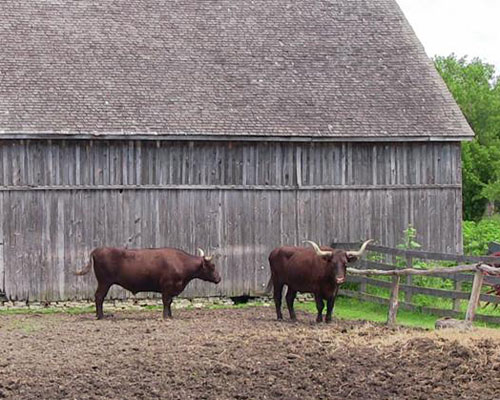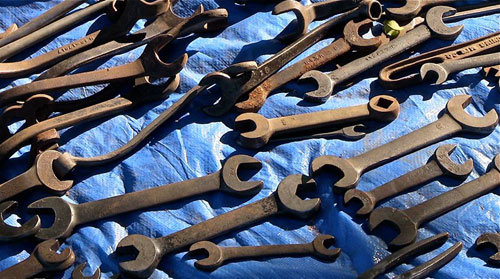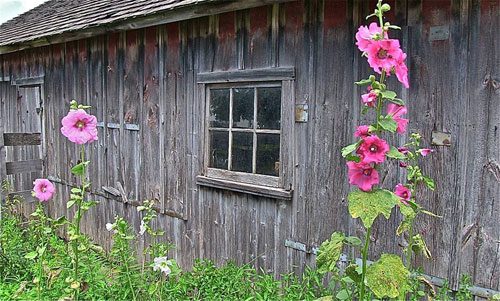

Specialty
Shows at Garfield Farm
|
|||||
 |
In times of economic uncertainty like the one we are in, any
threat to our food sources could be disastrous. Should a
disease or other factor make the breeds currently used not
viable, food would become harder and more expensive to come
by. What genetic diversity does is provide the option of a
different genetic strain that may not be affected by the
same things as the modern commonplace strain. Should the
currently used breed be effected the heritage breed may not.
There
is also the matter of taste. Many of the currently used
animals are used because they can grow to a desired size in
a relatively short amount of time. Some older breeds may
take longer to reach maturity, but they have a flavor to
their meat or eggs that is missing in the genetically narrow
market.
Breeders
are invited to exhibit their animals at the museum with a
chance to meet other breeders and prospective buyers. Pens,
water, and bedding are provided by the museum just bring
feed and any information, displays, products,
demonstrations, or lectures related to the breeds being
shown. There are no registration fees for exhibitors.
Exhibitors must have appropriate health paperwork on their
animals.
In addition to seeing the animals,
visitors and exhibitors can tour the 1846 Teamster Inn and
Tavern, watch demonstrations of sheep shearing, wool
spinning, or enjoy refreshments.
 |
Members
of the Early American Industries Association (EAIA) and the
Mid-West Tools Collectors Association (M-WTCA) will be
holding their annual Antique Tool Show and Sale at the
Garfield Farm Museum on Sunday, August 5th from 9am - 1pm.
This is the only joint show by these two organizations in
the mid-west open to the public. Over 30 different
collectors will have their tools on display and for sale.
In the past, skilled craftsmen used
specific tools for their livelihood and for their survival.
These craftsmen, such as coopers and blacksmiths, were
indispensable to their communities, and their work was
dependant on their tools. Each piece of equipment was vital
and had a specific purpose. As society became more and more
mechanized, the need for these craftsman and their tools
vanished. By understanding the use of these tools, one can
gain an understanding and respect for them.
Many antique tools most people come in
contact with are a mystery. They might not know what the
tool was used for or even who or how it was used. Not only
can the public view, and even buy the tools at the Antique
Tool Show and Sale, the collectors have an understanding and
experience that they share with the show’s guests.
Most tool organizations hold private
shows available only to their members. However, Garfield
Farm Museum has opened its gates to host the EAIA and
M-WTCA’s annual Antique Tool Show and Sale in order to give
the general public the unique opportunity to see and even
buy rare antique tools they might never have seen before.
Visitors and novice collectors will find this rare
chance to discover the wide variety of collection themes and
to learn the value of tools. Many visitors have come to the
show with an unknown tool and have left with a wealth of
knowledge. Tours of the 1846 teamster inn and tavern begin
at 11am and continue after the show until 4pm. Refreshments
will be available.
Garfield
Farm Museum holds its Annual Heirloom Garden Show in August.
During the show, visitors can tour the museum’s heirloom
gardens and interact with Midwestern growers showing off
their favorite heirloom flowers, herbs, fruits, and
vegetables.
The show highlights the importance of preserving genetic
diversity in the very plants that we rely on for food,
medicine, and enjoyment. Many of these heirloom fruits and
vegetables have unique tastes, cooking traits, appearances,
and disease or insect resistance that may not be found in
the more common grocery store varieties.
 |
The
chance to meet backyard gardeners, many of whom are members
of the Seed Savers Exchange (SSE), a nonprofit organization
that has connected plant enthusiasts from around the world,
is reason enough to attend the show. SSE is a
remarkable grass roots effort that began in 1975 and is
based out of Decorah, Iowa. Seed Savers receives a portion
of the proceeds from the show.
Exhibitors from Illinois, Indiana, and Iowa bring a wide
variety of heirlooms. As always for this show, garlic,
peppers, and tomatoes are well represented.
Visitors, young and old, can also delight in the museum's
own historic gardens. The heirloom flower garden houses many
old time favorites, such as, “Love Lies Bleeding” or “Kiss
Me Over the Garden Gate” that harken back to simpler times.
Hollyhocks, often remembered by those that grew up in the
country, bloom in various corners of the barnyard. The
heirloom vegetable garden is made up of varieties that the
Garfields themselves may have grown including rare
pre-blight potatoes. The garden offers children a chance to
see where the food they eat originates.
The kitchen garden by the tavern contains herbs and spices
as well as some native flowers. Accounts of the time
encouraged transplanting prairie flowers to the garden as
they were already disappearing from the 1840s landscape. The
Pottawatomie Garden Club of St. Charles has provided
monetary support for the museum’s gardens over the years.